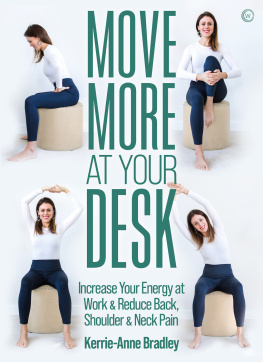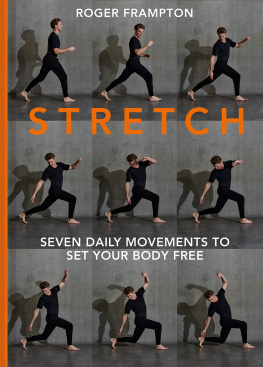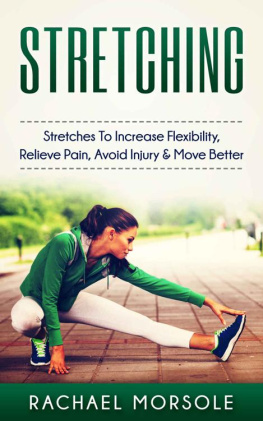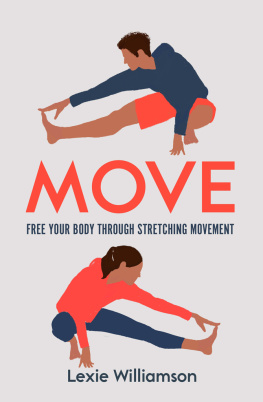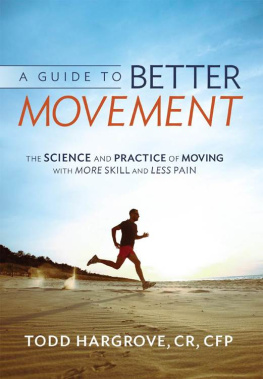
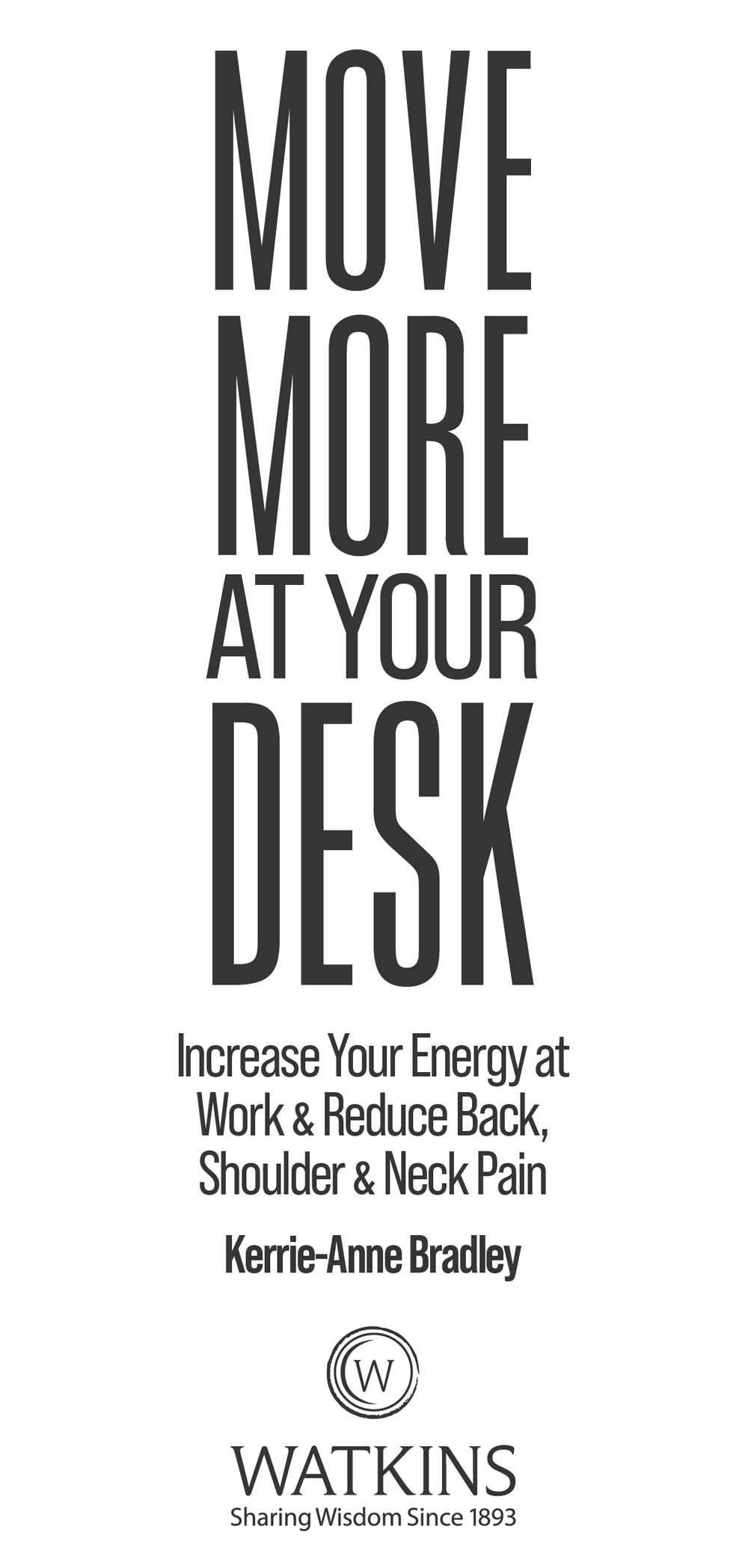
Move More At Your Desk
Kerrie-Anne Bradley
First published in the UK and USA in 2022 by
Watkins, an imprint of Watkins Media Limited
Unit 11, Shepperton House,
8393 Shepperton Road
London N1 3DF
enquiries@watkinspublishing.com
Design and typography copyright
Watkins Media Limited 2022
Text and illustration copyright Kerrie-Anne Bradley 2022
Photography copyright on cover and Chloe Williams 2022
Photography copyright on Stacey Horler 2022
Photography copyright on Will Pyne 2022
Photography copyright on Josh Tucker 2022
Photography copyright on Charlotte Green 2022
Photography copyright on Amy Whittingham 2022
The right of Kerrie-Anne Bradley to be identified as the Author of this text has been asserted in accordance with the Copyright, Designs and Patents Act of 1988.
All rights reserved. No part of this book may be reproduced in any form or by any electronic or mechanical means, including information storage and retrieval systems, without permission in writing from the publisher, except by a reviewer who may quote brief passages in a review.
Commissioning Editor: Anya Hayes
Editorial Assistant: Brittany Willis
Head of Design: Karen Smith
Designer: Kate Cromwell
Illustrator: Johanna Arajuuri
Production: Uzma Taj
A CIP record for this book is available from the British Library
ISBN: 978-1-786786-07-4 (Paperback)
ISBN: 978-1-786786-23-4 (eBook)
10 9 8 7 6 5 4 3 2 1
Printed in Bosnia and Herzegovina
Disclaimer: All of the movements in this book are functional and safe. That said, should anything cause pain you should stop immediately and consult your medical practitioner. If you have any health conditions that are affected by movement, please consult your medical professional to identify which movements are contraindicated, if any.
www.watkinspublishing.com
The movements I share in this book are movements I have learnt along my movement journey. I did not invent them. However, the way that I teach them is in my own way and words. Where an exercise is particular to a person I have had experience working with, I have said.
Contents

Introduction
Lets Get Moving
Movement should be approached like life with enthusiasm, joy and gratitude for movement is life, and life is movement, and we get out of it what we put into it.
Ron Fletcher
This is a book about simple ways to move more while you work. It isnt about running around the block 10 times, doing 100 press-ups every hour or jumping in the air and landing in the box splits its about small, simple and varied ways to move more so that your body is less stiff, stronger, more energized and feels good.
If you are someone who spends a lot of time sitting at work and/or a lot of time sitting when not working, then this book is for you.
It provides a toolkit of movements for you to try and a practical guide on how to integrate more movement into your day.
The underlying message of this book is that moving around is better for our bodies than staying still for long periods of time. For many of us, though, sitting is a major part of how we work, and so much of our lives is also geared toward sitting these days: eating, commuting, watching TV, scrolling on our phones the list could go on!
So, unless we intend to ditch all our chairs and sign up to a seat-free life, we need to think about how we sit. This book will therefore also show you how to sit (and stand!) in an active and balanced way.
Our bodies are designed to move, and can do this in many different ways, and at varying speeds. There is no disputing that for those of us who hold our bodies in a relatively fixed position for several hours a day, introducing a variety of movements is a good thing. The examples in this book will hopefully show you how to explore your movement potential without even having to leave your workspace.
This book is about breaking down the barriers that prevent us from moving, which is why the movements are simple, accessible and quick, and why no special equipment or clothing is needed for them.
The aim is to leave you feeling more informed about moving your body during the day so that you can feel energized, stretched, better aligned, stronger, calmer and hopefully happier. For those of you with desk-related pain, I hope that the advice and suggestions here will leave your body feeling less achy too.
This is a practical guide to moving more at your desk, so I will be asking you to sit on your sit bones (youre going to hear quite a lot about this ) and FIDGET.
My Movement Journey
My name is Kerrie-Anne, and I am an ex-professional sloucher turned Pilates teacher. I have a business called Pilates At Your Desk (PAYD), where I teach individuals and businesses across the world how to move more and how to sit/stand in a balanced and active way while at work.
Many years working as an economist, sitting like a cross between a pretzel and a croissant (for the non-imagery learners among you, this will be explored later) really took its toll on my body: I had constant shoulder pain, sciatica, an awful lower back and dodgy knees!
I quit my job as an economist and retrained with Fletcher Pilates, which is a Pilates school started by one of the first-generation teachers (meaning that he trained directly with Joseph Pilates himself, who created the method), Ron Fletcher.
So what is Pilates? In short, it is a programme of strength, flexibility and mobility movements looking to bring about better alignment and balance throughout the mind and body. This repertoire of movement either performed on a mat or on specially-developed Pilates equipment was first developed by Joseph Pilates in the early 20th century. In daily life, and indeed in sport, we will use particular parts of our bodies on a repetitive basis. Some parts become overused, while others are underused. Pilates is about getting the parts that do not move as much, moving. It is about working those smaller, deeper muscles and engaging the mind to focus on how to do that.
At the time, I saw the teaching course as a stop gap while I figured out what I would do next, but when I started teaching, I realized I had found my calling. I had been looking at bodies my whole life (lots of time spent on benches eating lunch, watching the world go by). As a result, I had connected lots of dots and could generally figure out why a person was experiencing discomfort or pain, based on how they walked, sat, lay and stood still. So now, instead of working as an economist, I go around applying my problem-solving skills to pelvises and spines. I specialize in alignment and also work with lots of people with limited mobility due to injury or particular medical conditions.
I would describe my approach as somewhat intuitive insofar as I am guided by the body in front of me. I continue my education with regular workshops but, that said, much of the development of my knowledge tends to come from what I learn from those I teach. I base my Pilates lessons on what the body needs. More often than not, when the body is in a place of pain or discomfort, what is required are simple moves and tips on how to change how the body moves, or indeed how it is static, on a daily basis. This is where I see the biggest results in terms of benefits to wellbeing.
Next page
